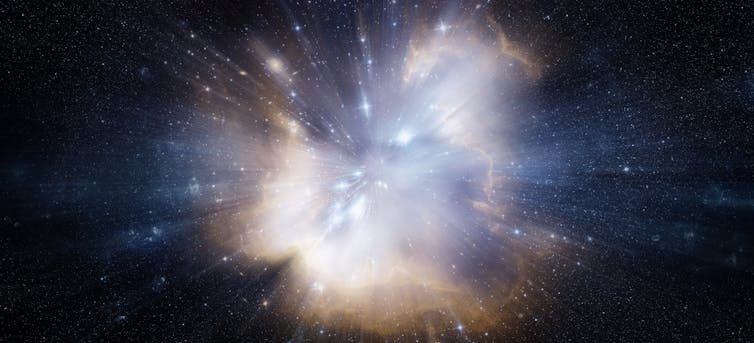New discovery at Cern could hint at why our universe is made up of matter and not antimatter
Why didn’t the universe annihilate itself moments after the big bang? A new finding at Cern on the French-Swiss border brings us closer to answering this fundamental question about why matter dominates over its opposite – antimatter.
Much of what we see in everyday life is made up of matter. But antimatter exists in much smaller quantities. Matter and antimatter are almost direct opposites. Matter particles have an antimatter counterpart that has the same mass, but the opposite electric charge. For example, the matter proton particle is partnered by the antimatter antiproton, while the matter electron is partnered by the antimatter positron.
However, the symmetry in behaviour between matter and antimatter is not perfect. In a paper published this week in Nature, the team working on an experiment at Cern, called LHCb, has reported that it has discovered differences in the rate at which matter particles called baryons decay relative to the rate of their antimatter counterparts. In particle physics, decay refers to the process where unstable subatomic particles transform into two or more lighter, more stable particles.
According to cosmological models, equal amounts of matter and antimatter were made in the big bang. If matter and antimatter particles come in contact, they annihilate one another, leaving behind pure energy. With this in mind, it’s a wonder that the universe doesn’t consist only of leftover energy from this annihilation process.
However, astronomical observations show that there is now a negligible amount of antimatter in the universe compared to the amount of matter. We therefore know that matter and antimatter must behave differently, such that the antimatter has disappeared while the matter has not.
Understanding what causes this difference in behaviour between matter and antimatter is a key unanswered question. While there are differences between matter and antimatter in our best theory of fundamental quantum physics, the standard model, these differences are far too small to explain where all the antimatter has gone.
So we know there must be additional fundamental particles that we haven’t found yet, or effects beyond those described in the standard model. These would give rise to large enough differences in the behaviour of matter and antimatter for our universe to exist in its current form.
Revealing new particles
Highly precise measurements of the differences between matter and antimatter are a key topic of research because they have the potential to be influenced by and reveal these new fundamental particles, helping us discover the physics that led to the universe we live in today.
Differences between matter and antimatter have previously been observed in the behaviour of another type of particle, mesons, which are made of a quark and an antiquark. There are also hints of differences in how the matter and antimatter versions of a further type of particle, the neutrino, behave as they travel.
Equivalent amounts of matter and antimatter were generated by the Big Bang.
Triff / Shutterstock
The new measurement from LHCb has found differences between baryons and antibaryons, which are made of three quarks and three antiquarks respectively. Significantly, baryons make up most of the known matter in our universe, and this is the first time that we have observed differences between matter and antimatter in this group of particles.
The LHCb experiment at the Large Hadron Collider is designed to make highly precise measurements of differences in the behaviour of matter and antimatter. The experiment is operated by an international collaboration of scientists, made up of over 1,800 people based in 24 countries. In order to achieve the new result, the LHCb team studied over 80,000 baryons (“lambda-b” baryons, which are made up of a beauty quark, an up quark and a down quark) and their antimatter counterparts.
Crucially, we found that these baryons decay to specific subatomic particles (a proton, a kaon and two pions) slightly more frequently – 5% more often – than the rate at which the same process happens with antiparticles. While small, this difference is statistically significant enough to be the first observation of differences in behaviour between baryon and antibaryon decays.
To date, all measurements of matter-antimatter differences have been consistent with the small level present in the standard model. While the new measurement from LHCb is also in line with this theory, it is a major step forward. We have now seen differences in the behaviour of matter and antimatter in the group of particles that dominate the known matter of the universe. It’s a potential step in the direction of understanding why that situation came to be after the big bang.
With the current and forthcoming data runs of LHCb we will be able to study these differences forensically, and, we hope, tease out any sign of new fundamental particles that might be present.
William Barter works for the University of Edinburgh. He receives funding from UKRI. He is a member of the LHCb collaboration at Cern.




